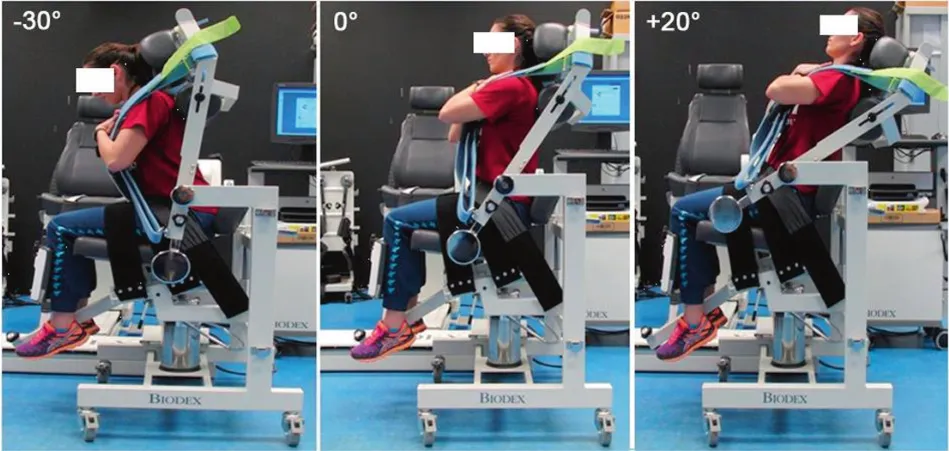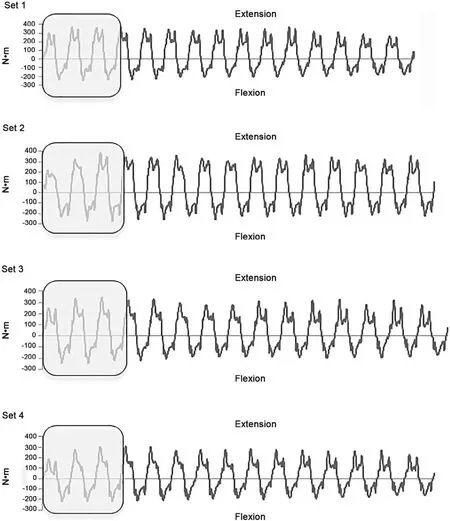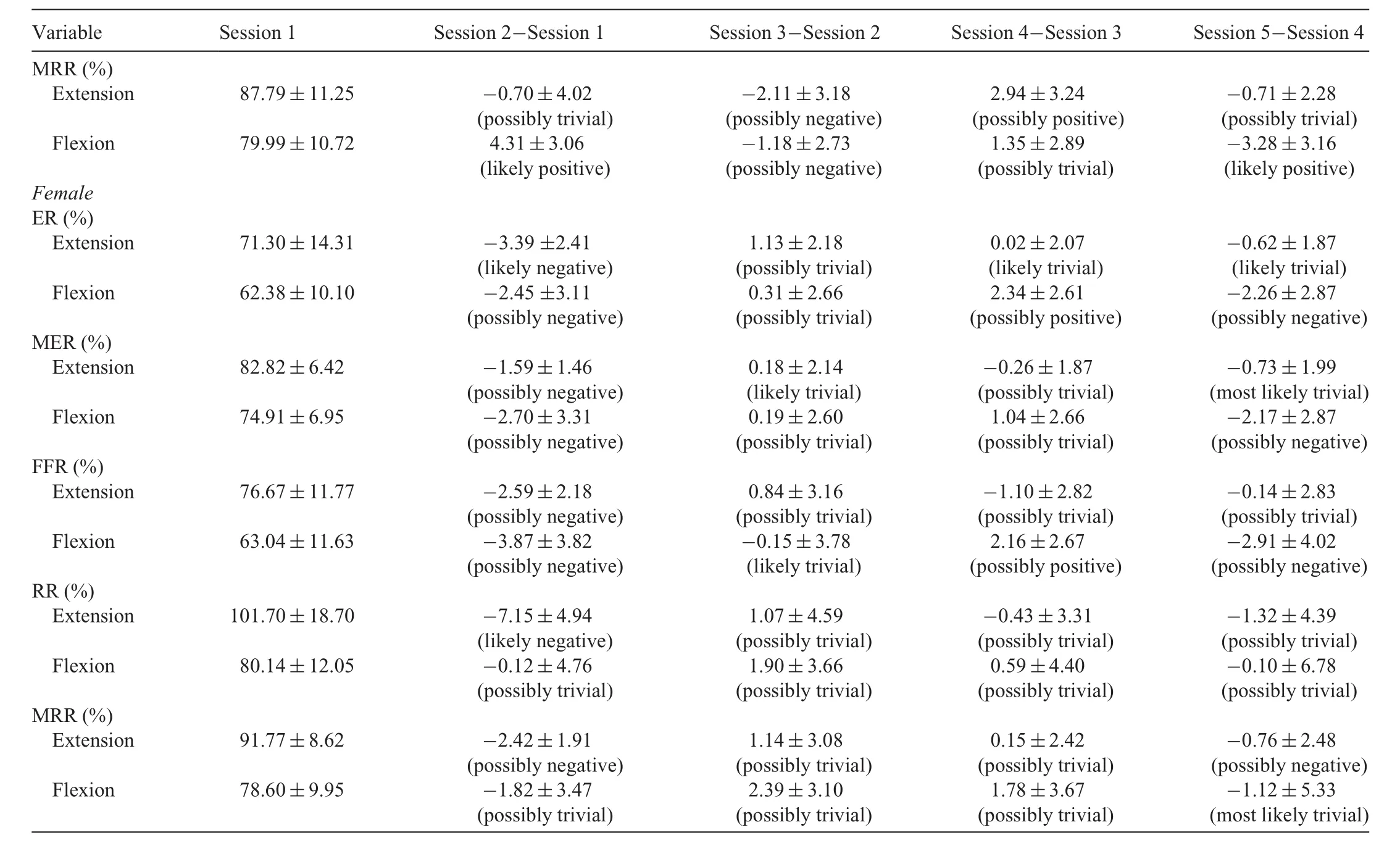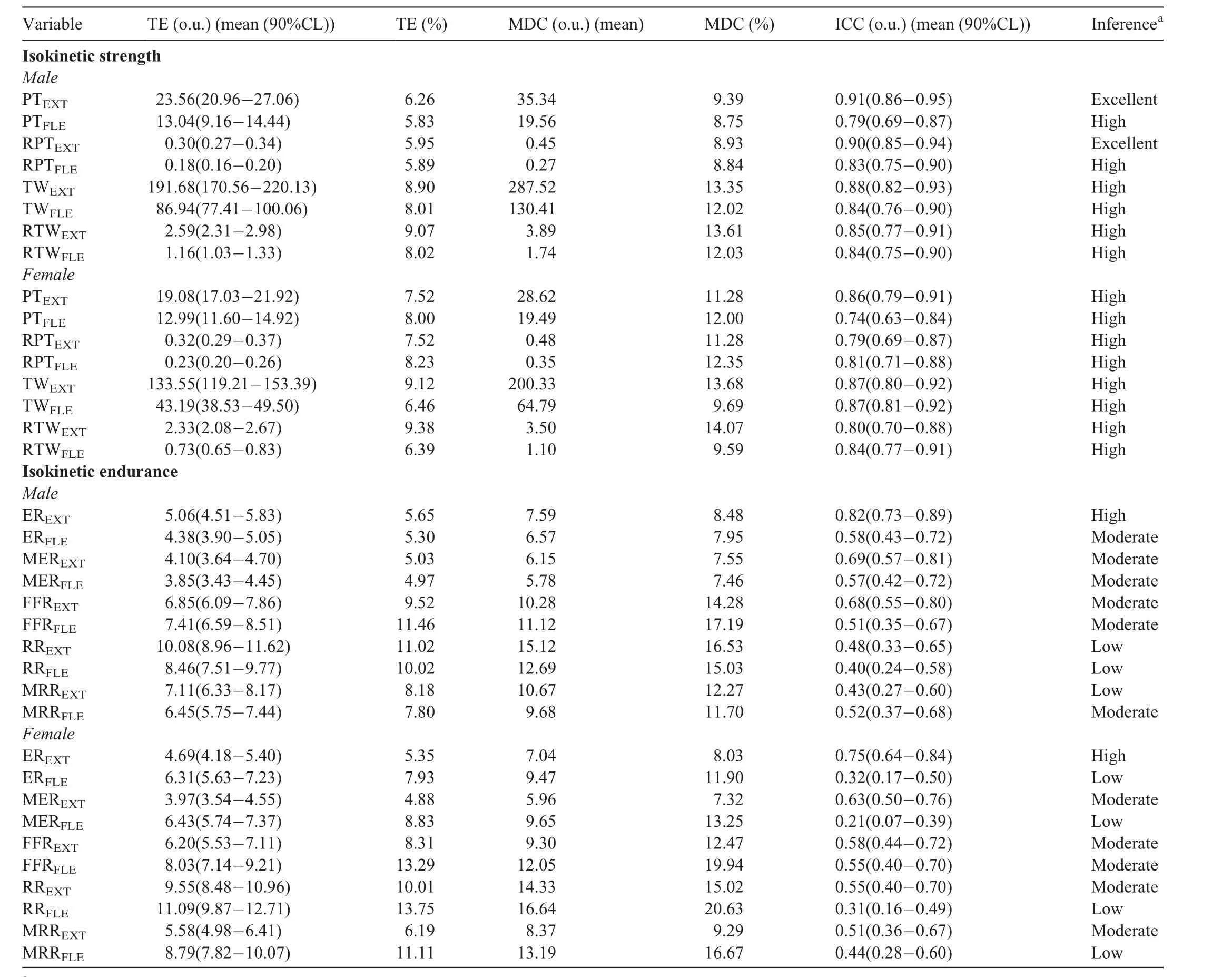Isokinetic trunk flexion-extension protocol to assess trunk muscle strength and endurance:Reliability,learning effect,and sex differences
2020-12-18MarPilarGarcVaqueroDavidBarbadoCastoJuanRecioAlejandroopezValencianoFranciscoVeraGarcia
María Pilar García-Vaquero,David Barbado,Casto Juan-Recio,Alejandro L′opez-Valenciano,Francisco J.Vera-Garcia*
Sports Research Centre,Miguel Hernandez University of Elche,Elche,03202,Spain
Abstract Purpose:The purpose of this study was to examine the reliability and the learning effect of an isokinetic trunk flexion-extension protocol designed to simultaneously assess trunk muscle strength and endurance.In addition,the effect of the participants'sex on the reliability data was examined.Methods:Fifty-seven healthy and physically active young men(n=28)and women(n=29)performed the isokinetic protocol 5 times,separated by a week between each of the first 4 sessions and by a month between the last 2 sessions.The protocol consisted of performing 4 trials of 15 maximum flexion-extension concentric exertions at 120°/s(range of trunk motion=50°).The absolute and relative peak torque and total work were calculated to assess trunk flexion and extension strength.In addition,endurance ratio,modified endurance ratio,fatigue final ratio,recovery ratio,and modified recovery ratio variables were used for the assessment of trunk muscle endurance in both directions.Results:Regarding the absolute reliability,no relevant changes were found between paired-comparison sessions for most strength and endurance variables,except for total work and relative total work variables in the flexion movement in both sexes.In addition,the typical error of the isokinetic variables was lower than 10%in both males and females,and minimum detectable changes ranged from 7%to 20%,with a tendency to be higher in females and in endurance variables.The strength variables showed high-to-excellent intraclass correlation coefficients(ICCs;>0.74);however,for the endurance variables only the endurance ratio and the modified endurance ratio obtained moderate-to-high ICC values(0.57<ICC<0.82).In addition,the analysis of the variance reported no significant differences between consecutive pairs of sessions for most variables in both sexes.Conclusion:Overall,these findings provide clinicians,trainers,and researchers with a 10-min single-session protocol to perform a reliable muscle strength and endurance evaluation of trunk flexor and extensor muscles,all within the same protocol.
Keywords:Core muscles;Fitness;Isokinetic dynamometry;Performance;Spine;Testing
1.Introduction
The contribution of the trunk musculature to many sports(e.g.,taekwondo,judo,tennis,golf,baseball,handball,rowing,etc.)1-5and daily life activities has aroused considerable interest in trainers,clinicians,and researchers.6,7In the field of sports,it is thought that increases in the ability to exert the maximum trunk muscle force(trunk muscle strength),as well as the ability to exert trunk muscle force repeatedly or continuously over a long period of time(trunk muscle endurance),can improve athletic performance1,8,9and help prevent and treat back disorders in individuals with trunk muscle weakness.4,10For these reasons,many field and laboratory protocols have been developed to assess trunk muscle strength and endurance in sports, fitness,clinical,and research settings.
For decades,isokinetic dynamometry has been widely used to measure trunk muscle strength in sports performance1,11,12as well as to identify injury risks13,14and to assess the progress of rehabilitation programs15,16in clinical settings.The main reasons for its popularity are the validity and reliability shown by the isokinetic instrument,17the relative and absolute reliability of the isokinetic strength protocols,18-21and the ability to measure different muscle groups while controlling contraction type,angular velocity,range of motion,body position,number of repetitions and sets,etc.22In addition,because previous studies have not found a learning effect for these protocols,18-21,23-26participants do not have to carry out a long period of practice before testing.
In contrast,trunk muscle endurance has normally been evaluated using field tests27-30because they are easy to perform,do not require large and expensive equipment,and allow numerous people to be evaluated all at once in a short period of time.However,several researchers have questioned their use,especially in the field of sports,for several reasons:(1)the lack of specificity of some protocols to trunk demands for a particular sport;7,8,31(2)the in fluence of individual anthropometry32and test practice/experience28on scores;and(3)the large absolute reliability of most field protocols,32-34which brings into question their ability to detect real improvement in the athletic population.35Based on the isokinetic dynamometry characteristics presented here(i.e.,instrumental reliability,performance control,nonlearning effect,etc.),isokinetic trunk endurance protocols could be an alternative to field tests;however,to the best of our knowledge there are few studies on isokinetic trunk endurance,1,36,37and only the study by Mayer et al.37has assessed protocol reliability.In this study,2 different trunk muscle strength and endurance protocols were analyzed,and only the strength variables showed high reliability,whereas the reliability of the endurance variables was considerably lower.
Taking into account the lack of isokinetic trunk endurance protocols and the time constraints in sports and clinical settings,which make performing several protocols difficult,an isokinetic trunk flexion-extension protocol was developed to simultaneously evaluate both trunk muscle strength and trunk muscle endurance.The protocol was based on those developed by Mayer et al.37and had a short execution time(approximately 10min),which facilitated its use in professional and scientific fields.Although this protocol has recently been used to show the contribution of trunk muscle function to high-level performance in judo,1its reliability has not been analyzed.Therefore,the main purpose of this study was to assess the absolute and relative reliability and the learning effect of this new isokinetic trunk flexion-extension protocol.In addition,we examined the effect of the participants'sex on the reliability data,because there are only a few studies on isokinetic trunk dynamometry that do not show consistent results that have evaluated protocol reliability depending on the participants'sex.23-25
2.Methods
2.1.Participants
Fifty-seven healthy young volunteers,28 males(age:24.1±3.3 years;height:176.0±5.2cm;mass:75.4±8.6kg;mean±SD)and 29 females(age:22.2±3.8 years;height:164.1±4.8cm;mass:59.0±7.1kg),took part in this study.They were physically active,performing 1-3h of moderate physical activity 1-3 days per week.Participants,who were recruited from the university population,took part in a variety of recreational physical activities such as team sports,aerobic exercises,and strength workout routines,but none of them was involved in trunk strength and/or endurance training programs.They completed a questionnaire about their medical and sports history to assess their health status and regular physical activity.None of the participants reported a recent history of back injury,abdominal surgery,or inguinal hernia,and all participants were free of neurological,cardiorespiratory,or musculoskeletal disorders.All subjects were informed of the risks of this study and signed an informed consent based on the 2013 Declaration of Helsinki,which was approved by the Ethics Committee of the Miguel Hernandez University of Elche.
2.2.Testing protocol description
The isokinetic trunk protocol was performed on a Biodex isokinetic dynamometer(Model 2000,System 4 Pro;Biodex Corporation,Shirley,NY,USA).Participants were placed on the dual-position back extension- flexion attachment of the dynamometer with the trunk upright,the hips and knees flexed at 90°,the thighs parallel to the floor,and the dynamometer axis of rotation aligned with the imaginary line joining the anterior superior iliac spines.38This was considered the anatomic reference position(Fig.1).To hold the participant to the dynamometer attachment,adjustable pads were placed behind the head,the sacrum,and the upper trunk and on the anterior surface of the tibia;in addition,Velcro straps were placed on the upper trunk,the thighs,and the pelvis.The trunk range of movement was limited at 50°,with 30°(-30°)of trunk flexion and 20°(+20°)of trunk extension,relative to the anatomic reference position(0°)described earlier(Fig.1).According to Grabiner and Jeziorowski,38ranges of trunk motion no larger than 50°would isolate lumbar motion,reducing hip flexion-extension.Moreover,the location of the dynamometer axis of rotation at the anterior superior iliac spine level and the use of the pad behind the sacrum and the strap on the pelvis minimized hip motion during the protocol.
The protocol consisted of 4 sets of 15 consecutive maximum concentric trunk flexion and extension efforts with 1min rest between sets.1It started from the flexion position and was performed with an angular velocity of 120°/s.This angular velocity was chosen because it was considered to be safe and reliable for measuring mechanical work.39Participants were told to keep their hands and arms crossed over their chest during the protocol.In addition,they were instructed to perform the maximum effort from the beginning of the first set and to maintain it until the end of the test.Moreover,they were verbally encouraged with the same indications and intensity across repetitions to exert maximum physical effort throughout the protocol.20,40

Fig.1.Participant performing a maximum effort of trunk flexion-extension in the isokinetic dynamometer with a range of motion of 50°(-30°trunk flexion;0°initial position;and+20°trunk extension).
Before testing,participants carried out a warm-up that consisted of 1 set of 10 submaximum trunk flexion-extension exertions at testing angular velocity(120°/s).This warm-up period helped participants become familiar with the equipment and test execution.The overall testing duration was approximately 10min.
Taking into account that at least 3 administrations of a protocol were needed to estimate its reliability accurately,41each participant executed 5 testing sessions of the isokinetic trunk flexion-extension protocol.All the trials were performed at the same time of the day and were managed by the same researcher.For each participant,the position on the dynamometer was recorded in a log sheet during the 1st testing session and was controlled across sets(adjusting pads and straps)and testing sessions to ensure protocol reliability.19-21,40There was a 1-week rest period between the 1st,2nd,3rd,and 4th testing session.However,because a weekly 1-min trunk training session has shown to be effective to improve trunk flexor endurance in adolescents with no experience in trunk exercise programs,42a 1-month rest was given between the 4th and 5th testing sessions to examine the possible in fluence of a training effect on the reliability analysis.

Fig.2.Force time-history of a participant for the isokinetic protocol(4 sets×15 repetitions).As has been explained in Section 2.3,the first 3 repetitions(shaded)were not used for the data analysis.
2.3.Data reduction
Fig.2 shows an example of the force time-history for the isokinetic trunk protocol.The first 3 repetitions of each set were discarded to avoid nonreal maximum executions related to the beginning of the isokinetic performance,because most participants reached their maximum strength values after the 4th repetition(82.9%and 72.9%for the extension and flexion movement,respectively).Therefore,12 repetitions per set(i.e.,the 4th to 15th)were considered for further analysis.
The absolute(raw scores)and relative(scores divided by body mass)peak torque(N⋅m)and relative peak torque(N⋅m/kg)and the absolute and relative total work(TW)obtained from the entire set(in joules(J))and relative total work(in J/kg)were calculated for each set.Considering that most participants did not achieve the maximum strength values during the 1st set,especially for the extension movement(75%of the participants),the strength values obtained in the 2 best sets were averaged for each variable and direction to assess trunk flexion and extension strength.
In addition,5 variables were used for the assessment of trunk muscle endurance in both directions(expressed in percentages):
1.Endurance ratio(ER),obtained after dividing the work(W)performed during the last 3 repetitions of each set by the Wperformed during the 4th,5th,and 6th repetition of each set and multiplied by 100.37

2.Modified endurance ratio(MER),obtained after dividing the W performed during the last 3 repetitions of each set by 3 times the maximum W(MW)reached in any repetition during the set and multiplied by 100.

3.Fatigue final ratio(FFR),obtained after dividing the W performed during the last 3 repetitions in the last set by 3 times the maximum W performed in any repetition of any set and multiplied by 100.1,37

4.Recovery ratio(RR),obtained after dividing the TW performed during the last set by the TW performed during the 1st set and multiplied by 100.37

5.Modified recovery ratio(MRR),obtained after dividing the TW performed during the last set by the maximum TW(maxTW)performed in any set and multiplied by 100.

Notice that ER and MER represent the ability to maintain the force output throughout each set,whereas FFR,RR,and MRR represent the ability to maintain the force output between sets.Therefore,a lower value for these variables represents a higher drop in trunk muscle force throughout the repetitions and/or sets,that is,a lower endurance score.Because many participants did not show a force decrement during the 1st set(mainly in extension direction)for ER and MER,the 3 sets with the lowest scores were averaged for further analyses.
2.4.Statistical analyses
The distribution of raw data sets was checked using the Kolmogorov-Smirnov test,which demonstrated that all data had a normal distribution(p>0.05).Descriptive statistics including means and SDs were calculated separately for each variable for both males and females.Brie fly,a 9(4 strength variables and 5 endurance variables)×5(testing sessions)×2(males and females)analysis of variance with repeated measures in the last factor was used to identify score differences between sessions(i.e.,learning effect).When significant differences were obtained,post hoc ttest analyses with Bonferroni adjustments were performed for multiple comparisons.Mauchly's test was used to check the assumption of sphericity of the data.
The detection of a possible heteroskedasticity of the random error distribution between paired sessions was done with calculation of Pearson's correlation coefficient(r)between absolute individual test-retest differences and individual means of each consecutive pair of sessions.No significant correlations showed the absence of heteroskedasticity,so raw data were used for the statistical analyses.43,44
To analyze the intersession absolute reliability of each variable,the typical error(TE;within-subject variation)and the change in the mean(between consecutive pairs of sessions)with their respective 90%con fidence limits and the minimum detectable change(MDC;1.5×TE)were calculated using the method previously described by Hopkins41and Hopkins et al.45The absolute reliability was calculated to average the reliability for the consecutive pairs of testing sessions(2-1,3-2,4-3,and 5-4).The TE was established using the following formula:where SDdiffis the SD of the difference between consecutive pairs of sessions.The change in the mean was calculated as the mean difference between consecutive pairs of sessions.For the change in the mean,the probability that the true value of the effect was positive,trivial,or negative was inferred as follows:most unlikely,<0.5%;very unlikely,0.5%-5%;unlikely,5%-25%;possibly,25%-75%;likely,75%-95%;very likely,95%-99%;and most likely,>99.5%.45The current study considered a“relevant or substantial”change when a change between paired-comparison sessions was statistically significant(p>0.05)and the probability of the worthwhile differences was “likely”or higher(>75%;positive or negative).
The relative reliability of the different measures was analyzed using the intraclass correlation coefficient(ICC2,1),calculating 90%con fidence limits.According to Hopkins41and Hopkins et al.,45the ICC was calculated from the analysis of variance(F-1)/(F+k-1),in whichFis theFratio for the subject term andkis the number of trials(i.e.,2).The ICC values were categorized as follows:excellent (0.90-1.00),high(0.70-0.89),moderate(0.50-0.69),and low(<0.50).46

Table1Descriptive values(mean±SD)for testing Session 1,the change in the mean between consecutive testing sessions(mean change±90%CL)and their probabilistic inference about the true magnitude of change are reported for the isokinetic strength and endurance variables.
Statistical analysis was performed with the SPSS statistics software(Version 18.0 for Windows 7;SPSS Inc.,Chicago,IL,USA),establishing significance asp≤0.05.

Table1(Continued)
3.Results
Descriptive statistics and the change in the mean between consecutive testing sessions for the isokinetic strength and endurance variables are displayed in Table 1.For the strength variables in males and females,the change in the mean was generally above “likely trivial”,except for specificcases.Furthermore,the analysis of variance with repeated measures indicated no significant interaction effect among sessions for the extension movement in any variable or either sex.In contrast,in the flexion movement a few slightly significant differences were found(Table 1).These differences were mainly detected when we compared Session 1 with the rest of the sessions,because it showed higher strength values(Fig.3).
For the endurance variables(Table 1),the changes in the mean were mainly “possibly trivial”for both males and females in flexion and extension movements,except for a few cases.In addition,the analysis of variance with repeated measures reported no significant differences between consecutive pairs of sessions.
Test-retest reliability statistics for the isokinetic strength and endurance variables(between consecutive pairs of testing sessions(2-1,3-2,4-3,and 5-4))are presented in Table 2.To facilitate result comprehension,data have been presented as the mean of the 4 paired testing sessions.
The strength variables(Table 2)showed mean ICC values above 0.74(0.74<ICC<0.91)and mean TE values below 10%(5%<TE<10%),whereas minimal detectable change was lower than 15%(8%<MDC<15%).Comparing males and females,similar relative and absolute reliability values were obtained.
The endurance variables(Table 2)showed lower relative reliability values compared with strength variables,especially in females and in trunk flexion movement.However,ER and MER for trunk flexion and extension movements and final fatigue ratio for trunk extension movement in males,and ER ratio and modified endurance ratio for trunk extension movement in females,presented moderate-to-high mean ICC scores(0.57<ICC<0.82).
Regarding absolute reliability,most variables showed mean values of TE below 10%(4%<TE<10%),but FFR(for flexion)and RR in males and females and MRR(for flexion)in females presented mean values that ranged from 11%to 14%.Minimal detectable change ranged from 7%to 20%,tending to be higher in females than in males.

Fig.3.Evolution of absolute(A)and relative(B)total work throughout the 5 sessions of the study for flexion direction.Asterisks over or under the error bars mean significant differences between Sessions 1 and 2.Data presented as mean±SD.J=joules.

Table2Mean of test-retest reliability statistics between consecutive testing sessions for the isokinetic strength and endurance variables expressed in the o.u.Probabilistic inferences are presented for the ICC.
4.Discussion
Although isokinetic dynamometry protocols are commonly used to assess trunk muscle strength in clinical and sports fields,they have seldom been used to evaluate trunk muscle endurance.1,36,37The purpose of this study was to examine the reliability and the learning effect of an isokinetic protocol designed to simultaneously assess trunk muscle strength and endurance in physically active males and females.The main findings of the current study were the high and moderate relative reliability for the strength and endurance variables,respectively.Thus,both variables seem adequate for ranking individuals according to their strength or endurance level.41,47In addition,strength and endurance variables showed low absolute reliability values,indicating that they may be useful in detecting real changes when an intervention(treatment or training)is applied.41,47Finally,significant improvements in strength and endurance variables were not found across sessions,suggesting that a single testing session could be enough to assess trunk muscle strength and endurance.
Regarding the relative reliability,isokinetic strength variables in flexion and extension efforts showed high-to-excellent ICC values in both males and females(0.74<ICC<0.91)(Table 2).These findings agree with previous studies in which the strength was measured in different isokinetic conditions(velocity,range of motion,isokinetic devices,subject placement,etc.).18,20,21,25,37,40,48Overall,the results of all these studies indicate the robustness of isokinetic measures in assessment of trunk muscle strength.
Concerning endurance variables,we found moderate-tohigh ICC values for those variables that assessed the drop inthe performance within sets(ER and MER(0.57<ICC<0.82)),mainly for flexion-extension movements in males and for extension movements in females(Table 2).However,those endurance variables that evaluated the drop in the performance between sets(FFR,RR,and MRR)obtained low relative reliability values(Table 2).It is possible that the rest time between sets was enough to allow some participants to partially recover from the effort performed,reducing or avoiding the drop in strength between sets in these participants.In the same way,some participants may have adopted conservative strategies during the protocol,not performing a maximum effort from the beginning of the protocol,which can be seen in some participants by the lack of a drop-off in work performance.37,40In general,the ICC values obtained in this study were higher than those found by Mayer et al.37using similar variables(0.35<ICC<0.42),maybe because in our protocol participants performed 4 sets and in Mayer et al.'s protocol participants performed 2 sets.
Regarding the absolute reliability,overall,strength,and endurance variables showed typical percentage errors close to or below 10%in both males and females(Table 2).Although there are no clear guidelines to decide the adequate cutoff that ensures the precision of the measurement,some authors have suggested that a variability of a measure lower than 10%could be considered appropriate for clinical and research purposes.43,49Therefore,most strength and endurance variables analyzed in this study seem to have good test-retest absolute consistency.To the best of our knowledge,no previous studies have examined the absolute reliability of isokinetic trunk endurance protocols.In relation to the isokinetic strength protocols,we found similar18-21or better23,24,26absolute reliability than previous studies did,which could be due to the fact that the angular velocities23and ranges of motion18,21used in some of the previous studies were higher than those used in our protocol(120°/s and 50°trunk motion).In this sense,angular velocities higher than 120°/s could increase the error between sessions,23and large ranges of motion could result in a misalignment between the biological axis of the trunk and the mechanical axis of the dynamometer.19,24
With the intention of improving the interpretation of the absolute reliability,the minimum detectable change was assessed,which in terms of practical applications can be used to indicate the limit for the smallest change that indicates a real improvement in the measurement after an intervention.50The results show that changes over 14%in strength variables and over 20%in endurance variables(Table 2)would be needed to ensure that the observed changes are real changes rather than measurement errors or participants'variability.In addition,the general trivial changes observed between consecutive testing sessions for strength and endurance variables may support the idea that no systematic error associated with learning effects occurred.
Interestingly,the reliability obtained in trunk extension exertions was slightly higher than the reliability observed in trunk flexion exertions,mainly in endurance variables.In the present study,the differences between extension and flexion directions could be due to the structure of the dynamometer used.The Biodex isokinetic dynamometer has a rigid support both in the back and in the front of the legs(Fig.1),helping participants to consistently transmit the forces from the lower extremities to the trunk during extension exertions.However,the dynamometer does not have these rigid structures on the chest or behind the legs,which could make the performance of maximum flexion exertions more difficult and,therefore,less consistent.In this sense,with the goal of enhancing flexion exertion reliability,it would be interesting to modify the dynamometer structure by implementing a rigid support on the chest and behind the legs to allow better force transmission in both phases of the movement.
Regarding reliability differences between males and females,both samples presented similar relative and absolute reliability values.These results support those previously obtained by Delitto et al.23but differ from those by Dvir et al.24and Keller et al.,25who found higher reliability values for females and males,respectively.In addition,most isokinetic studies of other muscle groups have shown worse reliability results in males than in females,probably as a result of a higher difficulty of controlling the males'body position during the protocol.In this sense,the higher anthropometric dimensions and the higher experience in maximum efforts of some males in these studies may have allowed them to exert higher forces,25so inappropriate strapping could have changed the initial position,affecting the pelvic axis alignment.19,24,40On the contrary,the lack of reliability differences between sexes in the current study could be caused by(1)an adequate position standardization in the attachment of the dynamometer via the different adjustable pads and straps used;(2)the control of body position acrossthe sets;and/or(3)similar male and female experience withperforming maximum efforts,which could decrease the differences between them.Although males and females obtained similar reliability values,both samples showed large differences in trunk muscle performance(Table 1).Males showed higher trunk flexion and extension strength and higher trunk flexion endurance than females,but no sex differences were observed for trunk extension endurance.
For a comprehensive analysis of isokinetic protocol reliability,the learning effect was assessed through 5 testing sessions.Although a few significant differences were found for total work and relative total work,generally the strength and endurance variables showed no significant differences between sessions in both sexes(Table 1),demonstrating the consistency of the measurements.In addition,when small differences were found for the strength variables,a reduction between the 1st and the rest of the sessions was observed(Fig.3),which cannot be interpreted as a learning effect of the protocol.The reason for this decrease may be the lack of motivation of the participants because of the extensive and intensive demands of the protocol(i.e.,4×15 maximum flexion-extension exertions)and the long study duration(i.e.,5 testing sessions in 8 weeks).Therefore,only 1 session would be enough to obtain reliable strength and endurance values in this protocol.These results are supported by previous studies that also analyzed strength variables and found no significant differences between sessions.18-21,23-26
Application of the data of this study is limited to healthy and physically active young males and females.Future investigations should include individuals with different spinal conditions,ages,physical activity levels,and so on.In this sense,because of the high physical demands of this protocol,some modifications may be needed for untrained individuals or those with low back injury(e.g.,increasing warm-up duration,reducing angular velocity and number of sets,etc.).In addition,as has been explained earlier,our results are in fluenced by the characteristics of the dynamometer used in this study(e.g.,adjustable pads and straps,rigid supports,etc.).Thus,if this protocol is carried out using other dynamometers,it would be advisable to perform new reliability analyses.Another limitation of this study is that the participants'body mass was measured only in the 1st testing session.Although researchers did not appreciate significant weight variations in the participants,and the reliability of the relative peak torque and relative total work(variables that depend on a participant's body mass)was high,anthropometry changes throughout the study could affect our results.
5.Conclusion
The findings of this study provide trainers and researchers with a 10-min single-session protocol to perform a reliable muscle strength and endurance evaluation of trunk flexor and extensor muscles,all within the same protocol.Based on the good reliability results obtained for all strength variables,any of them could be used to assess trunk muscle strength in physically active young males and females.However,regarding the endurance variables,ER and MER showed the best reliability results,mainly in the extension direction and in males.
Acknowledgments
This research was made possible by the financial support of Ministerio de Ciencia e Innovaci′on(DEP2010-16493)and Generalitat Valenciana(ACOMP/2011/130),Spain.Casto Juan-Recio and Alejandro L′opez-Valenciano were supported by predoctoralgrantsgiven by GeneralitatValenciana(Val i+d)(ACOMP/2011/130)and Ministerio de Educaci′on,Cultura y Deporte(FPU)(DEP2010-16493),respectively.The authors wish to thank the participation of the university students who offered their time to take part in this research.
Authors’contributions
MPGV participated in the protocol design,carried out the testing sessions,performed the data reduction and statistical analysis and drafted the manuscript;DB participated in the protocol design,data reduction,and statistical analysis and drafted the manuscript;CJR participated in the data reduction and statistical analysis;ALV participated in the testing sessions and data reduction;FJVG conceived the study,participated in the protocol design and its general coordination,and helped to draft the manuscript.All authors have read and approved the final version of the manuscript,and agree with the order of presentation of the authors.
Competing interests
The authors declare that they have no competing interests.
杂志排行
Journal of Sport and Health Science的其它文章
- Effects of compression garments on surface EMG and physiological responses during and after distance running
- Postural control quantification in minimally and moderately impaired persons with multiple sclerosis:The reliability of a posturographic test and its relationships with functional ability
- Residual force enhancement due to active muscle lengthening allows similar reductions in neuromuscular activation during position-and force-control tasks
- Health-related fitness knowledge growth in middle school years:Individual-and school-level correlates
- Habitual physical activity levels and sedentary time of children in different childcare arrangements from a nationally representative sample of Canadian preschoolers
- Walking-friendly built environments and objectively measured physical function in older adults
